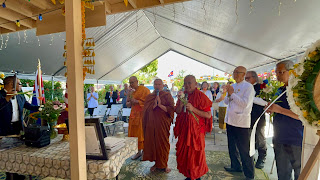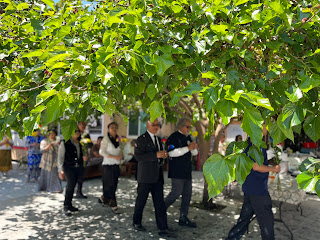Remembrance and Justice in Cambodia - 49 Years after the Khmer Rouge Atrocities
“… A society cannot know itself if it doesn't have an inaccurate memory of its own history.”
- Youk Chhang, Director, The Documentation Center of Cambodia.
Introduction
April 17, 1975, marked the end of one chapter and the beginning of another, signifying the total victory of the Khmer Rouge over the Khmer Republic, and the commencement of a period characterized by unimaginable pain, immense suffering, anger, and lasting grief— infamously known as "Khmer killing Khmer", war crimes, mass atrocities, crimes against humanity, genocide and widespread devastation in Cambodia. On that pivotal day, the Khmer Rouge forces seized control of Phnom Penh, evacuating the city's residents hours later as part of their radical social engineering policies, forcibly relocating millions of people to rural areas in an attempt to create an agrarian utopia. Over the subsequent three years, eight months, and twenty days, the Khmer Rouge turned Cambodia back to “Year Zero” which resulted in the deaths of approximately 2 million people, about a quarter of the country’s population, through starvation, extrajudicial killings, forced labor, and disease. Among the deaths, were my mother, two brothers, and two sisters. They were forced to kneel at the edge of the mass grave while the Khmer Rouge cadres clubbed them on the back of their head with the hoe on 20 July 1977 at Commune Cheu Til Phlous, Village Cheyo, District Chamkar Leu, Province Kompong Cham province. This date also symbolizes the commencement of the darkest chapter in Cambodian history, serving as a solemn day of mourning and remembrance for the countless lives lost and the enduring trauma inflicted upon all Cambodian people.
Remembrance and Buddhist Rituals
Forty-nine years after the Khmer Rouge atrocities, I joined other fellow Cambodian elders and several young generations from the Killing Fields Memorial Center at Wat Pudtamongkol in Long Beach to “Remember victims of the Killing Fields on any April 17 rain or shine” (Killing Fields Memorial Center’s mission). This gathering provided a platform for survivors to speak openly and share their individual stories and the issues they have faced due to the enduring legacy of the Khmer Rouge. Commemorating this significant date is not merely about paying tribute to the countless lives lost in the Killing Fields; it also serves as a deep reflection on the profound destruction inflicted upon Cambodia's infrastructure and foundation – schools, banks, and telecommunications were shut down, and social fabric, familial structures, and religious practices were destroyed. These social and emotional wounds have left an indelible mark on the collective psyche of the Cambodian people, creating a lasting and profound impact on both the nation and its people. It is important for the Cambodian community that the lessons of the genocide must not be forgotten.
The majority of Cambodians practice Theravada Buddhism with a common saying asserting “To be Khmer is to be Buddhist”. This belief system has played a significant role in offering hope, resilience, solace, and healing to survivors of the Khmer Rouge regime. The core teachings of Buddha center on suffering, impermanence, compassion, and the path to liberation from suffering – providing a framework for understanding trauma and finding inner peace.
The commemoration ceremony began with the lighting of candles, burning incense at an altar, and offerings to the monks. Following the three bows to Buddha statues, and three to the monks, Lok Ta Achar, the elder officiant or facilitator, directed participants to make offerings (រតនបូជា) and pay homage to the Buddha, Dhamma, Sangha (ពទ្ធរតនបណាមធម្មរតនបណាម សង្ឃរតនបណាម) and the Triple Gems (ថ្វាយបង្គំរតនត្រ័យសង្ខេប). Ta Achar then guided our attention to the monks who administered the Five Precepts ceremony (សមាទាន និច្ចសីល- សិលប្រាំ), delivered a sermon (អារាធនាព្រះសង្សចំរើន ព្រះបរិត្ត) on Buddha’s teachings, and expounded on the practice of meditation (អារាធនាធម្មធិកសម្តែងធម៌ទេសនា -សមាធិ). Participants were asked to practice samadhi to be in the moment – sit comfortably and calmly focus on each incoming and outgoing breath for five minutes. Additionally, the monks performed Bangsokol (បង្សុកូល) – a Buddhist rite of passage that accompanies Cambodian funeral rites aiding the spirits of the dead into the next life.
After offering food and almsgiving (វេរចង្ហាន់ រាប់បាត្រ), the monks bestowed blessings upon the participants. To conclude the Buddhist Rituals, attendees dedicated merit to deceased relatives, and all sentient beings, praying that the benefits of their good deeds would extend to others. This gathering, blending religious observances with social services, provided practical assistance and emotional support to the survivors. May the merits accrued be shared with all beings, whether human or nonhuman, visible or invisible, distant or near. May the souls of the two million people who perished under the Khmer Rouge find solace.
Memory, Justice, and Searching for the Truth
As I look back forty-nine years after the Khmer Rouge atrocities, it is evident that time doesn't heal all wounds and grief. Many survivors I met still carry pain, suffering, and generational trauma. The haunting memories of the Killing Fields continue to dominate the minds and the behavior of the survivors who endured unspeakable horrors. Many of the emotional and psychological wounds inflicted by these atrocities remained unhealed. Dr. David Kenzie, Professor of Psychiatry, at Oregon Health Sciences University, who treated severely traumatized Cambodian refugee patients with post-traumatic stress disorder (PTSD) affirmed that “The patients are often numb, or focused on somatic or other symptoms an effort to avoid the past. It is a wound that does not heal”.
The Extraordinary Chambers in the Courts of Cambodia (ECCC), also known as the Khmer Rouge Tribunal (KRT), concluded its official work on September 22, 2022, sentencing the only surviving top leader, Khieu Samphan, aged 93, to life in prison. After 16 years and $337 million, resulting in just 3 convictions (the other two convicts Noun Chea passed away on August 4, 2019, and Kaing Guek Eav also known as Duch died on September 2, 2020) one may question the worth of the tribunal in delivering justice, uncovering the truth, and achieving genuine national reconciliation. Furthermore, while only three Khmer Rouge leaders were legally held accountable, numerous Khmer Rouge cadres who were directly ordered or participated in stabbing children, beating people to death, starving them randomly, and denying medical help to the injured have been allowed to live freely in the same village as the victims. This freedom has been granted, often without consequences, by the former Khmer Rouge defectors and a seemingly indifferent UN court. The top Khmer Rouge leader Pol Pot, a paranoid and a megalomaniac, was the mastermind behind the carnage and bore primary responsibility for the destruction of Cambodia. He did not face justice as he passed away in 1998, and some other senior Khmer Rouge leaders died before they could be brought to trial.
Furthermore, the agreement establishing the ECCC, a collaboration between international and government entities, limited its jurisdiction to the highest-ranking Khmer Rouge leaders primarily responsible for crimes from 1975 to 1979. This focus on addressing the most egregious atrocities came at the expense of disregarding the origins and aftermath of the Khmer Rouge era, including the 1970 military coup, U.S.-led bombing, and subsequent Vietnamese occupation. The vast majority of Khmer Rouge members implicated in and supporting these atrocities have yet to face accountability for their actions. Consequently, the failure to fully address the causes and consequences of the Khmer Rouge period perpetuates division within Cambodia. While Khmer Rouge defectors and current leaders commemorate January 7th, 1979, as the liberation of the Killing Fields and a second rebirth, many other Cambodians perceive the date as one of bitterness—the bitterness of the Vietnamese occupation of Cambodia from 1979 to 1989.
Survivors’ Four Distinct Attitudes
Based on my extensive interaction with the victims in Cambodia and abroad, survivors of the Khmer Rouge regime often display complex and varied emotions regarding the enduring pain and suffering they experienced. These feelings can be categorized into four distinct attitudes:
1. Forgive and Forget: Some adopt an attitude of acceptance, believing that "what's done is done." This perspective aligns with the government's position, as articulated by Former Prime Minister and Former Khmer Rouge Military Commander Hun Sen on December 25, 1998, urging to "dig a hole and bury the past."
2. Forgive but Not Forget: Another stance involves forgiveness without necessarily forgetting. It avoids retribution and punishment, instead trusting in Kamma to dispense justice.
3. Not Forgive but Forget: For some survivors, there's a focus on retribution, individual accountability, and punishment. This attitude may involve suppressing memories and numbing feelings to alleviate ongoing suffering.
4. Not Forgive and Not Forget: Lastly, some adamantly refuse to forgive or forget. They advocate for retribution, adherence to the rule of law, and holding individuals accountable. This perspective emphasizes the importance of justice and truth, viewing them as essential rights of the victims and survivors. It asserts that lasting peace and national reconciliation can only be achieved through comprehensive justice and truth, which extends beyond the interests of the state and international bodies like the UN.
Conclusion: Never Forget, Never Forgive, Never Again.
In Cambodia, the pursuit of justice and truth is not solely the responsibility of the state and international courts like the UN. Rather, it belongs fundamentally to the victims and survivors of the Khmer Rouge regime. Their voices, experiences, and quest for accountability are paramount for genuine reconciliation and finding closure. Remaining silent is not an option when injustice rules and the truth still needs to be uncovered.
As I departed Wat Pudtamongkol, I found consolation in the belief that kamma might ultimately deliver justice where the Khmer Rouge Tribunal fell short. The memory of April 17, 1975, remains ingrained in my mind as a powerful reminder: Never Forget, Never Forgive, Never Again.
References
David Kenzie, professor of psychiatry, Oregon Health Sciences University, and Jenelle Fleck, Psychiatrist nurse practitioner at Oregon Health Sciences University Psychotherapy with Severely Traumatized Refugees, American Journal of Psychotherapy, Vol. XLI, No2, January 1987.
DC-CAM: https://www.dccam.org/
ECCC: https://www.eccc.gov.kh/en
Erika Pinenos, March 5, 2023, When Transitional Justice Falls Short https://foreignpolicy.com/2023/03/05/transitional-justice-cambodia-colombia-khmer-rouge-tribunal/
Human Rights Watch, Cambodia: Khmer Rouge Convictions ‘Too Little, Too Late' https://www.hrw.org/news/2014/08/08/cambodia-khmer-rouge-convictions-too-little-too-late
Nicole Cochran, Andrew Wells-Dang, October 3, 2022, Never Again? The Legacy of Cambodia’s Khmer Rouge Trials, https://www.usip.org/publications/2022/10/never-again-legacy-cambodias-khmer-rouge-trials









No comments:
Post a Comment